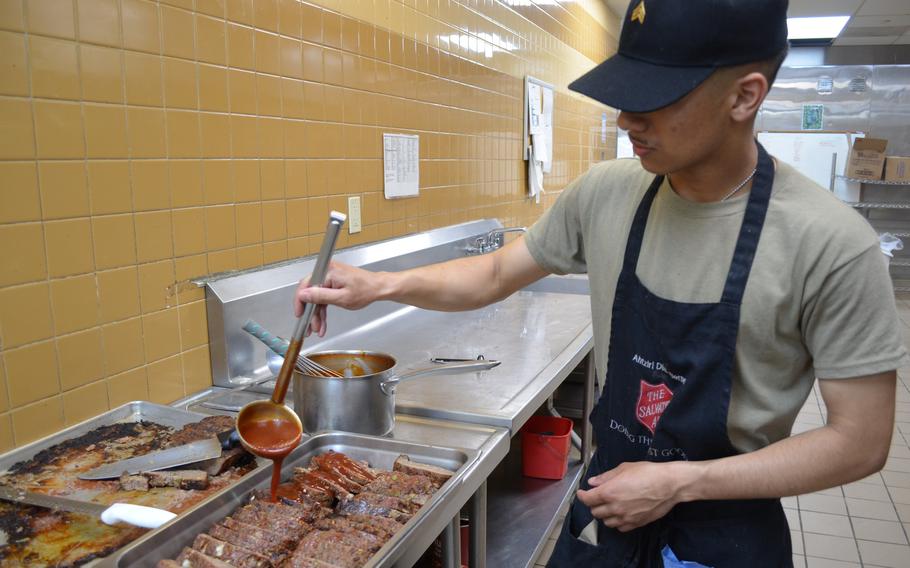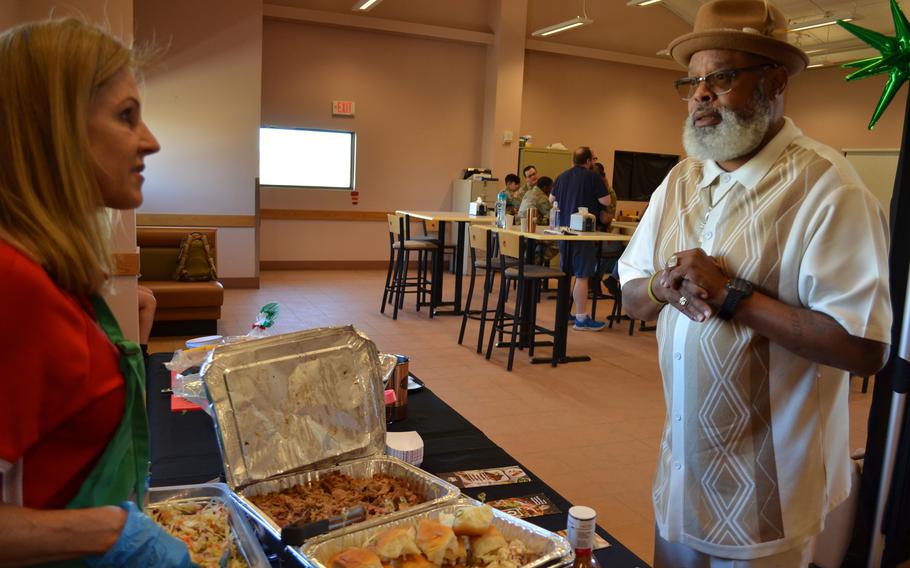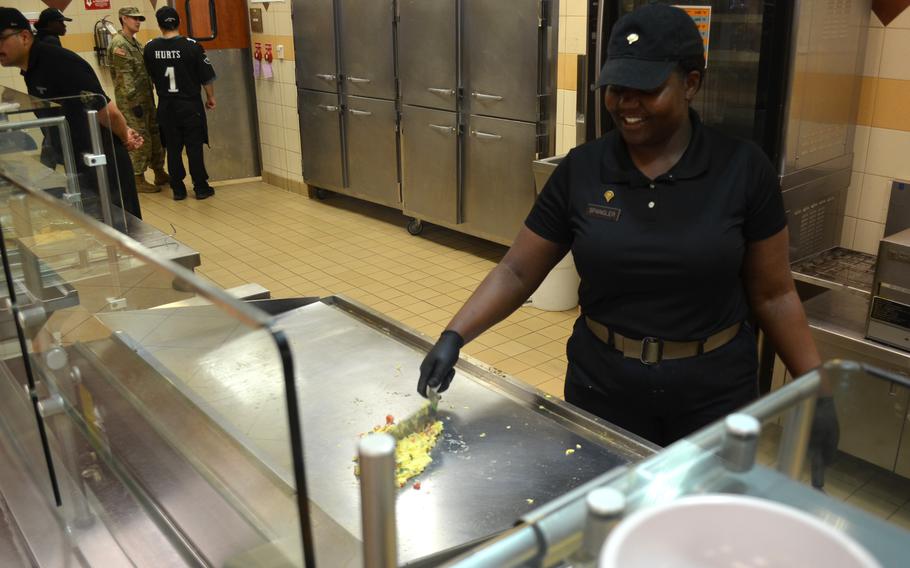
Army Sgt. Ahtziri Diaz-Bernes pours gravy onto meatloaf on May 15, 2025, at the Stack Dining Facility at Fort Carson, Colo. (Rose L. Thayer/Stars and Stripes)
FORT CARSON, Colo. — Sgt. Adam Mazeika, a medic at the Army base, said he tries to eat in the dining facilities on base as much as possible because the food isn’t bad and has helped him purposefully gain weight.
He likes to eat in the facility, but Fort Carson’s grab-and-go meals are now available later after the dining room closes, which allows him to complete an extra workout and not miss a meal.
“The kiosk is nice because I eat enough and have extra food,” Mazeika said. “The hours are perfect as long as you know them.”
He is part of a growing number of soldiers returning this year to the dining facilities at the base after officials found a way to increase the hours of operation and create more meal options.
The 4th Infantry Division pulled the food program from a low of only serving 250 meals in a weekend to a 700% increase in 18 months. The division did so by making certain dining facilities were open with consistent weekly schedules near soldiers living areas and any to-go options were in addition to regular meal service — not a replacement, said Sgt. Maj. Kendra Knuckles, senior chief culinary manager for the division.
By the end of the summer troops will also have the choice of grabbing meals from the division’s reimagined meal prep program, which is prepackaged meals intended to be reheated later by soldiers. A previous version of the program had about six meal options. By August, the division will rotate about 20 meals each at breakfast, lunch and dinner.
The division also opened the Carson Café, where soldiers grab a meal and eat in a lounge area with games and TVs.
“Be creative,” Knuckles said she tells facility managers. “Set the ambiance in your facilities. If you are doing a Mexican meal, or Tex-Mex, or whatever, put some merengue on so when the soldiers come inside the [dining facility], it flushes whatever they were dealing with and they just say, ‘Oh man, I like this.’ ”

Gregory Joell, Fort Carson food program manager, speaks with a vendor about products available to stock in dining facilities on May 16, 2025, at Fort Carson, Colo. (Rose L. Thayer/Stars and Stripes)
Listening and adapting
Knuckles and her counterpart Gregory Joell, Fort Carson food program manager and an Army retiree, couldn’t point to one reason for the base’s rebounded dining. It was a genuine response to the flood of feedback from soldiers — submitted internally and posted publicly online, including eight inquiries from members of Congress based on concerns from constituents.
The hours were confusing, so they built a consistent schedule instead of a rotating one. The portions were too small, so soldiers can now serve themselves buffet-style. The variety was stagnant, so managers have more leeway in creativity and specialty nights with themed meals. They have also added requested stations for fresh-made smoothies, burritos and do-it-yourself sandwiches.
“We are trying to support all these different folks’ way of eating, the way they were brought up,” Joell said.
During the week, the 4th Infantry Division culinary program serves an average of nearly 12,000 meals at all types of facilities.
About 6,000 soldiers on post are eligible for meal cards with an allowance affording them three meals a day, which they indirectly pay for through a basic allowance for subsistence that is deducted from their pay. The dining facilities are also open to anyone without a meal card who wants to pay out-of-pocket.
Sgt. Kyle Figueroa served as the driver for the previous division command sergeant major and said they would go to kiosks all the time for meals.
He loved the grab-and-go chicken and egg bagel with milk and a fruit platter for breakfast.
“It’s really convenient. It’s the best invention they’ve had,” Figueroa said of the dining facility changes. “I like the off-set hours because it gives you more time to eat.”
Army-wide systems slow to change
Bases across the Army are making similar changes to match the changing meal preferences of its newest generation of soldiers who less frequently eat together in a dining facility. Instead, there is growing demand for food to take home.
And yet, each base is on its own to develop standards and implementation for a grab-and-go meal prep program. There is no standard program for bases to build upon, nor does the standard payment system accommodate soldiers’ desire to take multiple meals home at one time.
Chief Warrant Officer Shedrick Swain, senior command food adviser for Army Materiel Command, said the Army is working to develop such a program for service-wide use, but it is in its infancy stage.
“It is a continually changing environment,” he said. “You’re moving at a rapid pace in terms of your mission, your day-to-day operations … and you are focused on just trying to grab a quick meal that meets nutritional needs and take a couple of moments to have some down time and enjoy your meal by yourself. That’s where a lot of younger service members are focused.”

Army Spc. Phionah Spangler cooks an omelet during breakfast service on May 16, 2025, at the Warfighter Dining Facility at Fort Carson, Colo. (Rose L. Thayer/Stars and Stripes)
About 60 facilities at 17 locations now do some form of meal prep with “pockets of excellence,” including Fort Hood in Texas and Schofield Barracks in Hawaii. There are 28 kiosks operating at 16 Army locations, Swain said.
Dining facilities are funded based on interactions, so they lose out when soldiers don’t come in for each meal. There’s also not a simple way to scan their ID card for more than one meal at a time.
The Army is also looking for a solution to this, Swain said.
“Overall, we don’t want to constrain or confine the initiative at all. This is something that has been successful in the early stages. We want this to continue to move forward and become a better product overall,” he said.
Humming in the background of this work is a contract to put a private company inside a dining facility at five installations in this order: Fort Bragg, N.C., Fort Stewart, Ga., Fort Hood, Fort Drum, N.Y., and Fort Carson, according to Materiel Command. A vendor proposal request closed this month.
Meanwhile, Knuckles has ramped up training for cooks in the division because the lack of a service-wide program also means soldiers aren’t getting training on meal prep programs. Standard culinary training for entry-level soldiers focuses on field feeding and dining facility operations, she said.
“Now you’re looking at a sergeant who has just shown up to her duty station and has to put a meal prep together, and she’s never done meal prep. She only did meal prep at home. She doesn’t know nutritional facts and guidance, so you have the training gap. There is the educational piece that you now have to try to plug in but do you have time to really plug them in?” Knuckles said.
Fort Carson hosts its own training opportunities for its cooks where she aims to encourage creativity in preparing meals in the dining facilities and the field. In addition, all cooks are now learning the base’s new meal prep options.
Knuckles does not want to see cooks unable to answer questions about the new meals or read information from a recipe card. She wants them to know and understand what they prepare for sale — not just the ingredients but the nutrition it provides.
“It’s building a team that can be able to effectively communicate what is in the products if soldiers have questions,” she said.